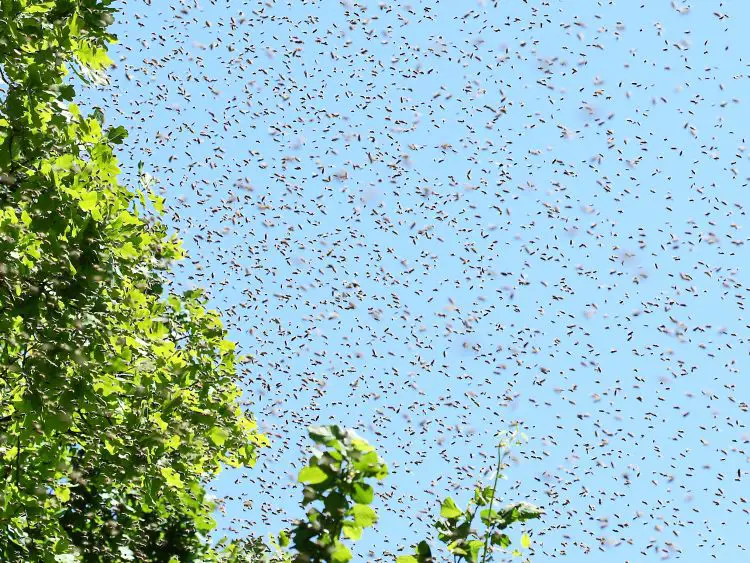There’s nothing quite as disheartening as realizing that your bees have up and taken off on you. You may think to yourself; “did I do something wrong?” And “How can I make sure this doesn’t happen again?”
Well, swarming does happen, plus certain species of bees are more prone to swarming than others, so even if you’re careful, you may have to deal with this issue one day. If this has already happened to you, or if you are just scared it may happen, take a look at our list below that we hope will shine a light on any mistakes you may have made, or may be able to avoid.
How To Prevent Bees From Swarming
Swarming happens when a colony of bees produces another queen and half of the bees decide to leave the hive with the new queen bee. It is how bees naturally produce new hives. Once the bees leave the colony, they cluster near the original hive in a large group around the queen while several scouts go look for a suitable home. A swarm can include tens of thousands of bees and can be quite a sight to see!
There are many reasons why bees swarm, some of them include: they’ve run out of room, the current queen isn’t doing a good enough job anymore, it’s too hot in the hive, or sometimes for seemingly no reason at all. While there are many things you can do to reduce the risk of swarms, none of them are 100% foolproof.
So while you can’t fully elimiate the risk of swarming, what you can do is make sure you’re doing everything you can to minimise that risk. Below are some of the most common ways you can lower the risk of swarming.
13 Ways Beekeepers Can Reduce The Risk Of Swarming
- You don’t want to go more than a week to 10 days without checking on each of your hives*. (There may be exceptions to this, such as after you’ve just introduced a new queen). Check for overall bee health as well as the below points.
- Some beekeepers like to replace the queen every year. New queens are less likely to cause issues with the hive. When the queen is the problem, it causes bees to swarm and leave with a new queen.
- Keep your hives away from direct sun as this can make it very hot inside the hive. A hot hive is not desirable to most bees, and they will want to leave if the temperature gets too hot for too long. Your Hives placement can have a huge impact on this.
- Add a few small holes near the top walls of the hive to help improve airflow. They also serve a dual purpose because bees can use them as an additional entrance to the hive.
- Water helps bees stay hydrated and it also gives them the ability to better regulate the temperature in their hive. Water also keeps bees healthier and can lead to more honey production long-term.
- Once a swarm cell starts to form, it’s too late to stop it, but you can get rid of the cells before all the bees leave. Additionally, if you’d prefer to wait, you can try and capture the swarm with the queen to create a new hive.
- Bees that think they are about to run out of space will swarm. When you do your regular checks, put in enough frames to account for hive growth. This gives bees the space they need to reproduce and store honey.
- No one likes to go outside in the rain, especially bees. All that time spent cooped up in their hive can make bees restless. They also tend to fill up a hive more quickly when they are stuck inside too long. If you make it a habit to check on your hives right after a few rainy days, you can add new frames to keep the bees from feeling cramped.
- Look for signs of swarms, pests, and make sure there are enough frames in each of your hives to allow for the burst of growth that happens when spring nectar starts.
- Some breeds are known for swarming. If you have a colony at a high risk of creating swarms, you’ll need to stay on top of issues before they arise.
- Springtime is a great time to split your hives. This is the time of year when most swarms happen and if you can get ahead of it by splitting the hive already, you won’t run into the issue of losing half of your hive.
- A hive out in the open where it’s too windy isn’t the best for bees. Find a way to shield your hives and protect your beehives from being affected by the wind.
- Sometimes the hive gets so crowded, the queen has nowhere to add new bees. This happens if the frames get too full of honey. You can go in and remove the honey and replace the frame with a new space for the queen to brood.
Why Should You Try To Prevent Swarming?
If you’ve ever harvested your honey, you understand the value of your bees. It can be very difficult to get much honey out of a hive after half of the bees leave. Additionally, when a swarm leaves, it creates a deficit that is hard for the rest of the hive to recover from. Bees that swarm will fill up on honey before they go which depletes the honey levels in the hive. This puts considerable pressure on the remaining bees, which means more energy will be needed to replenish honey reserves, or the colony risks collapse.
What If Your Bees Swarm Anyway?
So, you did everything you could to prevent the swarm, but now you watch as thousands of bees exit the hive and fill up the sky. They won’t go too far away. The swarm will look for a tree, a table, a car, or any place to land with the queen. As the beekeeper, your goal should be to capture the swarm before it finds a new permanent destination. It’s best if you can capture the queen that left, because as long as she’s in good shape, you can start a new hive so long as any the vacated hive has produced a replacement.
While swarms create challenges for beekeepers, it’s important to remember that they are a natural part of honey bee habits. When you regularly check your hive to ensure the environment is optimal, it can prevent most of the causes of bee swarming. But when you can’t stop it, try and capitalize on it instead.


![3 Big Mistakes Beginner Beekeepers Make [And How To Avoid Them!]](https://beekeepingabc.com/wp-content/uploads/2020/11/3-mistakes-beginner-beekeepers-make-90x75.jpg)

![Move over ducks, Queen Bees quack too! [Here’s Why]](https://beekeepingabc.com/wp-content/uploads/2020/06/queen-bee-90x75.png)
![The Flow Hive 2 Review [ Vs. The Classic Flow Hive]](https://beekeepingabc.com/wp-content/uploads/2020/02/Flow-Hive-2-90x75.jpg)
![How Bees Fly [10 Facts About How, When, and Why]](https://beekeepingabc.com/wp-content/uploads/2019/12/A-Bee-Flying-90x75.jpg)